
Edinburgh, 19 October 2021. – Following a successful launch on Saturday, analysis showed that Lucy’s second array had not fully latched. NASA is currently investigating what caused the failure and how they could achieve full deployment of the solar array.
The solar panels were successfully deployed 91 minutes after a smooth launch. Lucy is operating well and is stable, the arrays are producing power and the batteries are charging. NASA says that the spacecraft can continue to operate as normal and there is no threat to its safety.
Lucy’s two solar panels are 7.3 m in diameter each and have a combined 51 square m of solar cells. These were stored in a folded configuration for launch and were supposed to unfurl “like Chinese fans,” NASA said. The Northrop Grumman-built arrays can generate 18 kW of power in the vicinity of the Earth. However, when the spacecraft reaches its destination, the solar arrays will only produce 500 W of power. The large arrays are therefore needed in order for the spacecraft to fly out to Jupiter’s distance from the Sun.
It is unclear how the problem will affect the mission in the long run but NASA is confident the issue will be resolved. Lucy is on its way to explore one main-belt, and seven Trojan asteroids over the next 12 years. The spacecraft will act as a cosmic palaeontologist, flying past these eight cosmic fossils, studying their surfaces with infrared cameras.
 SpaceWatch.Global An independent perspective on space
SpaceWatch.Global An independent perspective on space




